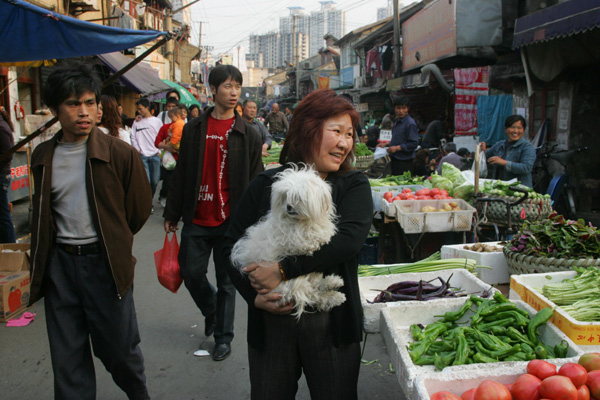|
 |
|
Vegetable stalls along a narrow lane in Shanghai. The scene that housewives elbow their way to bargain for a good price in fresh food markets in downtown Shanghai is a thing of the past, as most markets have been demolished to make way for commercial properties. [Photo/China Daily] |
Fresh food markets become part of Shanghai's history as they give way to real estate development
Visiting the market is part of Gu Xiuyun's daily routine. Carrying her basket, the 72-year-old walks through the narrow lanes near her home in Huangpu district for five minutes before arriving at the Ningbo Road Fresh Market in Shanghai.
Once there, she wanders around the 100 stalls, which sell a wide range of fresh foods from pickles, eggs, meat, seafood, vegetables and poultry.
Markets like this are steeped in local history, but this one is slightly special as it is just a stone's throw away from Shanghai's glitzy Bund. Here, luxury stores sit next to five-star hotels and expensive restaurants. Property prices are sky high.
But that is a different world to the one that Gu lives in. As she walks around the market, she picks a small piece of pork, a tailhail fish, bean curd, mushrooms and a cabbage for the family's lunch and dinner on Friday.
"In my neighborhood, the number of fresh markets shrank from four to only one in the past three decades," Gu said. "I hope this may last another 10 years or maybe more, so I can always walk here everyday."
Extensive property development in downtown Shanghai has meant that many fresh markets have moved to less central locations. According to the city's urban planning data, the 22 indoor fresh markets that had been around since the 1950s have now moved or closed down.
Social studies research reveals that many fresh markets were closed because they were a safety hazard or badly run. But many were woven into the very fabric of Shanghai and were well managed, selling a wide range of fresh foods to local residents.
High-end commercial projects now stand on their sites. the North Shaanxi Road wet market, which opened in 1928, was dismantled in the 1990s. Retail and office buildings now stand on the site of the old market, selling luxury brands such as Chloe and Mont Blanc.
The Sanjiaodi, literally meaning "delta", fresh market opened in the late 19th century. It was Shanghai's largest indoor fresh market until it was closed to make room for a high-rise office project in the 1990s.
"Fresh markets are actually not just places for residents to buy food," Zheng Zu'an, an historian with the Shanghai Academy of Social Sciences, said. "They are places for people to chat and to exchange information. They play an important role in local social life."
